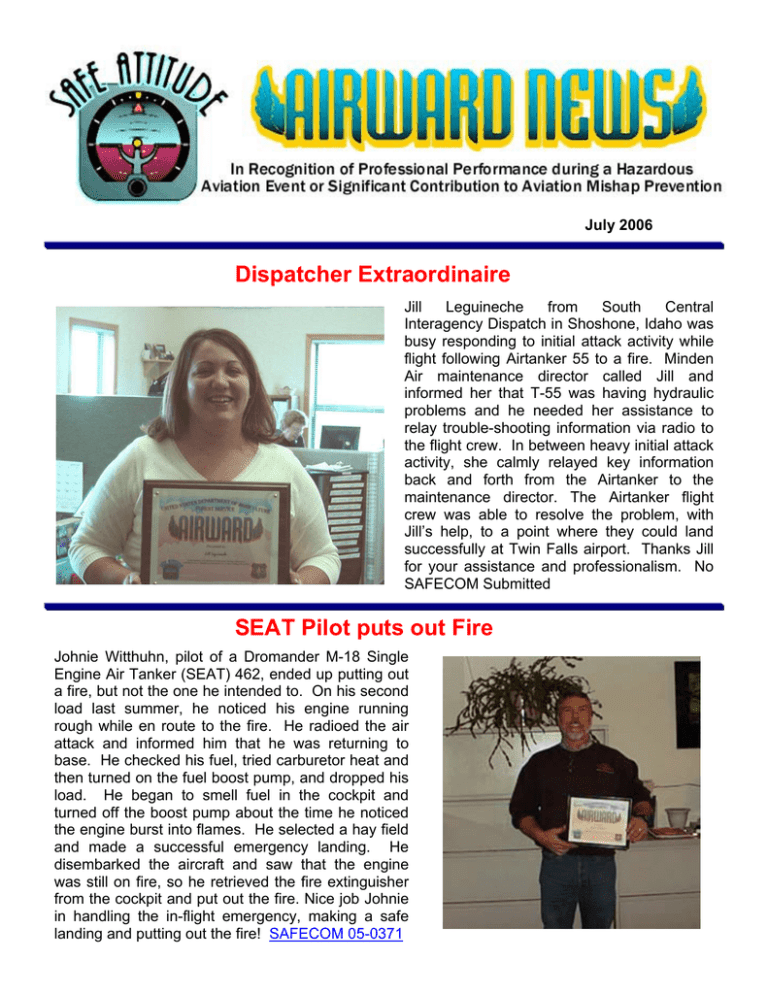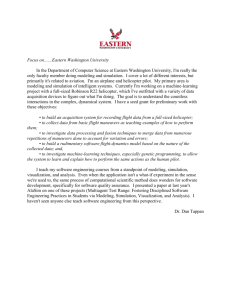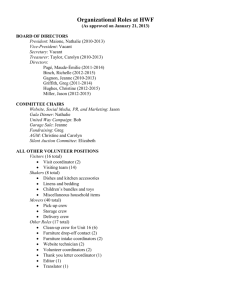Dispatcher Extraordinaire
advertisement

July 2006 Dispatcher Extraordinaire Jill Leguineche from South Central Interagency Dispatch in Shoshone, Idaho was busy responding to initial attack activity while flight following Airtanker 55 to a fire. Minden Air maintenance director called Jill and informed her that T-55 was having hydraulic problems and he needed her assistance to relay trouble-shooting information via radio to the flight crew. In between heavy initial attack activity, she calmly relayed key information back and forth from the Airtanker to the maintenance director. The Airtanker flight crew was able to resolve the problem, with Jill’s help, to a point where they could land successfully at Twin Falls airport. Thanks Jill for your assistance and professionalism. No SAFECOM Submitted SEAT Pilot puts out Fire Johnie Witthuhn, pilot of a Dromander M-18 Single Engine Air Tanker (SEAT) 462, ended up putting out a fire, but not the one he intended to. On his second load last summer, he noticed his engine running rough while en route to the fire. He radioed the air attack and informed him that he was returning to base. He checked his fuel, tried carburetor heat and then turned on the fuel boost pump, and dropped his load. He began to smell fuel in the cockpit and turned off the boost pump about the time he noticed the engine burst into flames. He selected a hay field and made a successful emergency landing. He disembarked the aircraft and saw that the engine was still on fire, so he retrieved the fire extinguisher from the cockpit and put out the fire. Nice job Johnie in handling the in-flight emergency, making a safe landing and putting out the fire! SAFECOM 05-0371 Some days you get the bear… and some days you don’t. During a polar bear tagging mission out of Barrow, Alaska Mr. Craig Bruce of Air Logistics Alaska had to make a tough call, but fortunately Craig was up to the challenge. On this day the polar bear was darted and instead of taking a little nap on the ice the bear headed for the open sea. The crew knew that if the bear made it to the water it would drown. Craig used all of the approved techniques to try and herd the polar bear away from the water but was unable to steer the bear to safety. Craig wisely realized that now was the time to stick to the book and not get too wrapped up in the moment. Craig’s professional approach allowed him to see the big picture and place the safety of his crew and his aircraft above the safety of the bear and accomplishing the mission. We congratulate Craig for having the situational awareness to see the big picture and resisting the temptation to innovate outside of his training and our policy. Good job Craig! No SAFECOM submitted. Quick Actions Save the Day Marci Danielson Jim Morrison presenting award to Joe Candlish (left) Joe Candlish was shuttling a crew to the Valley Road fire on the Sawtooth NF in his type II helicopter, when he heard Marci Danielson, the helibase manager announce that an unidentified aircraft had entered the TFR (Temporary Flight Restriction) area. Joe immediately scanned the area and when he looked to his right he saw a wing and cockpit window, sunglasses and all. He had to take aggressive action and banked to the right to avoid a mid-air collision. Great job Marci for alerting aircraft working in the area and to Joe for his quick response. SAFECOM 05-878 Pilot Keeps His Cool And Lands Safely Mike Maloney was preparing to land Tanker 451, an M-18T Dromader, at Nephi, Utah last summer when he found that the aircraft’s hydraulic system wasn’t working. At the time of the emergency the Nephi airport had a direct crosswind of approximately 15 knots so Mike decided to proceed to the Provo airport, which offered more choices for crosswind runways. Not knowing the cause of the hydraulic failure, and not knowing whether he had any hydraulic fluid remaining Mike elected to delay activating the auxiliary electrical hydraulic pump until just prior to landing to preclude the possibility of pumping any of the remaining hydraulic fluid overboard. Mike notified dispatch of his condition, and requested that they notify the Provo airport and request a rescue truck standing by. After checking ATIS, and contacting the Provo tower Mike learned that the winds were gusting to 18 knots, favoring runway 36, which was closed. Rather than attempt a crosswind landing with a hydraulics failure Mike requested runway 36, and the tower directed that the barricades and equipment be removed. Provo tower held traffic outside Class D airspace and cleared him to land on any runway. As Mike flew a low approach to runway 36 he saw that the wind had shifted to favor runway 31 and so he entered a downwind for runway 31. On base-to-final, Mike turned on the auxiliary electrical hydraulic pump and landed without further incident. Inspection revealed that the engine-driven hydraulic pump had failed internally. Due to Mike's training in emergency procedures, calmness under pressure, and exceptional situational awareness he was able to take a potential accident and turn it into an excellent lesson on aeronautical decision making. Good job Mike! SAFECOM 05-0783 Where’s the Air Guard Frequency? Kristi Cutler, the Klamath Falls Inter-agency Coordination Center Assistant Center Manager discovered a serious radio issue and notified the Center Manager. The air guard frequency had been removed from the dispatch center radio and no one was unaware of the removal. Air guard is an aviation frequency used in case of an in flight emergency to contact a dispatch center or someone on the ground. The emergency aviation frequency has been restored to the dispatch radio. The Klamath Falls Inter-agency Coordination Center Manager is commending Kristi’s safety attitude and observation. SAFECOM 05-314 No picture available Pilot commended for quick action and making a successful “Dead Stick” Landing Upon completing his third drop and starting to climb out Pilot Clint Knapp scanned his instruments and saw the low oil pressure light come on. He immediately notified the ATGS and keeps climbing towards the middle of the valley and headed for John Day airport. His instruments were showing normal readings at this time except for the low oil pressure and engine torque had dropped to 10%. He noticed a vibration in the engine and felt a slight power drop followed quickly by an engine chip light. He knows he only has a few seconds before the engine would probably quit and reacts immediately to feather the propeller, shut off the fuel and set up for the proper glide profile to get back to the airport. He was approximately 5 miles from the airport and he was able to gain enough altitude prior to the engine stopping to complete a successful “dead stick” landing to the airport. Air Tactical Group Supervisor, Tar Leismeister, and pilot Ron Jeffers, responded to the in-flight emergency with the SEAT in a professional manner providing Knapp with information and assurance to assist him during the emergency. Nice job guys! SAFECOM 05-0550 No Pictures submitted. John’s motto…… “Be Prepared” During the operation of an interagency prescribed burn for the Bureau of Land Management, a Bell 206L-3 helicopter equipped with a plastic sphere dispenser (PSD) struck an abandoned telegraph wire while attempting to dispense plastic spheres in a canyon near Carlsbad, New Mexico. After ensuring that all personnel and the aircraft were safe, John Cervantes, the Fire Helicopter Crew Supervisor at the Mescalero Agency, managed the notification process and the preservation of material necessary for the post-incident investigation. His planning and documentation contributed significantly to a timely and appropriate response to the incident once the initial notification was made. John’s actions during and after the incident flight showed a high level of professionalism, demonstrating his knowledge and experience to facilitate and contribute to a safe and proper response to a stressful situation. John, without hesitation, took the leadership role in ensuring that the Bureau and all parties complied with Departmental safety policy. John also demonstrated a high level of professionalism by ensuring that his unit had completed pre-event preparation and training so that when such an event did, in fact happen, it was no more complicated than taking care of business. Mr. Cervantes is deserving of recognition of his efforts in incident/accident preparedness and for his actions during and after the Carlsbad BLM wire strike incident. Mr. Cervantes’ conduct surrounding this event should be held as a fine example of how to do things right and to “be prepared.” SAFECOM 05-0325 Mike’s a winner with these cards Mike Spink from Lakeview Helitack produced emergency response cards for Lakeview’s crash rescue. The cards are simple, have enlarged printing and easily followed by first responders. The cards are located by the door leading to the helicopter pad. If there is an accident on the helicopter pad the crews are trained to take a card as they move through the door toward the accident. Each crewmember is to follow the instructions the cards, ensuring all rescue items are covered. The Region 6 Aviation Safety Manager has obtained copies of the cards and has recommended the cards for other Helitack locations. Additionally Mike produced enlarged charts of the crash rescue procedures for the B206L, B205, B212 model helicopters, which were taken out of the Interagency Helicopter Operations Guide (IHOG). Good move Mike. No SAFECOM submitted. No picture available. Helitack crew goes above and beyond… Last summer on the School fire helicopter N205WW, a Bell 205A1, from Wenatchee staffed with pilot Doug Uttecht, and rappel crew Keith Nantz, Ryan McCliment, Jerry Rule, and Johnny Valdovinos displayed a superior dedication to duty, reflected a high level of training and demonstrated the ability to handle an extreme situation with professionalism and safety. Nantz and McCliment were placed at a river dip site by 5WW. Two helicopters were working the fire from the dip site. After several water drops Uttecht told the airattack that he was returning to the dip site to evacuate the dip site managers because the winds had changed and the fire was now moving in that direction. As 5WW approached the grassy meadow to retrieve the fire crew Nantz instructed the helicopter not to land because fire was already in the meadow. The helicopter remained in the area as long as possible advising Nantz and McCliment of the fire advancement and relaying information to the lead plane, who advised the Incident Command (IC) about the status of the fire crew. The fire crew burned a safety zone in the meadow where they remained for several hours as the fire burned around them. Nantz and McCliment were retrieved from the meadow and taken to Clearwater Look Out. During the flight to the look out the crew heard a radio report about the fire indicating the fire had crossed several major ridges to the northeast. On previous flights to Lewiston many houses were noted in the area of the advancing fire. Nantz contacted Lead 88 inquiring about evacuation efforts ahead of the fire. Lead 88 was unable to reach IC and reported that evacuation efforts were unknown. 5WW was equipped with a PA system so it was decided by all the crew members, Uttecht, Nantz, McCliment, Rule, and Valdovinos, to fly ahead of the fire to ensure the houses were evacuated. Two civilian vehicles were discovered about ½ mile from the advancing fire setting in the middle of a fire retardant covered road. By using the PA system 5WW turned the vehicles around so they could safely evacuate the area to the south. The crew was prepared to pick the civilians up, if necessary and watched the vehicle movement until it was determined that they would make it out safely. 5WW moved to the houses, making announcements with the PA system but found no other civilians. 5WW continued working back and forth from north to south and encountered a large number of people about 5 miles in front of the fire. Using the PA system the people were persuaded to leave the area. 5WW remained in the area to watch the departure process until darkness forced them to return to Clearwater Look Out. Nice work guys! No SAFECOM submitted. No pictures available. Helitack to the rescue! Last summer a smokejumper was seriously injured while jumping on the Lind fire. The nature of the injury required immediate action and patient evacuation to save the firefighters life. The nearest life flight was in Las Vegas about 80 miles to the south, but the Las Vegas life flight could not respond because of the extreme afternoon heat and weather in Las Vegas. The Frazier helicopter pilot, Richard Shatto and crewmembers Kris Walters and Jon Scully were requested to provide the medical evacuation. The crew on 8CC suspended fire-fighting operations and configured the helicopter for the medivac, while other firefighters quickly built a helicopter landing area for the helicopter. The weather was poor with thunderstorms and low light conditions. Once the helicopter was on the ground, the patient was quickly loaded and prepared for the helicopter flight by Walters and Scully. A fixed-wing life flight aircraft had been requested to assist in the transportation of the patient to a Type 1 trauma center in Salt Lake City. Shatto determined the nearest suitable landing area for the medical airplane was Lincoln County, near Panaca, Nevada. The helicopter crew on 8CC communicated the intended landing airport to the local dispatch and arrived at Lincoln County 20 minutes ahead of the medical airplane. The helicopter crew on 8CC had to provide care for the patient until relieved by medical staff on the medical airplane. The helitack crew and pilot are commended for demonstrating the ability to handle an emergency situation in a safe and professionally and manner. Way to go guys! No SAFECOM submitted. No pictures available. Aviation Safety Offices http://www.fs.fed.us/fire/av_safety/ - http://www.oas.gov/oassafty/





